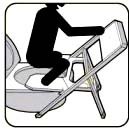|
We Ignore Squatting
|
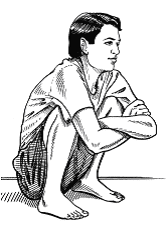
|
Sitting, on the other hand, obstructs the passage of waste through the colon. Elimination is difficult, requires straining and can never be complete.
Many people today remain unaware that sitting toilets pose a danger to their health and well-being.
In his book, A Guide to Better Bowel Care: A Complete Program for Tissue Cleansing Through Bowel Management, chiropractic physician and nutritionist Dr Bernard Jensen identified the sitting toilet as a health threat to mankind:
| "It is my sincere belief that one of the bowel's greatest enemies in civilized society is the ergonomic nightmare known as the toilet or john." |
To understand why squatting is better than sitting, one just need to have a basic understanding of how the colon works...from the point where food leaves the stomach...
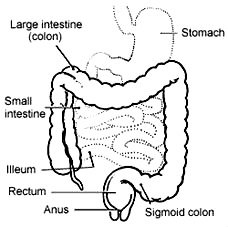 From the stomach, food (all mixed and ready) goes into the small intestine where nutrients are absorbed. The food wastes then goes into the large intestine or colon. When it enters the colon, it is in a liquid state.
From the stomach, food (all mixed and ready) goes into the small intestine where nutrients are absorbed. The food wastes then goes into the large intestine or colon. When it enters the colon, it is in a liquid state. However, as it moves through the colon, water is continuously extracted, and it turns into solid waste (stools) by the time it reaches the rectum. It is then passed out through the anus.
It is crucial that the colon can perform its role efficiently and effectively. All waste must be evacuated on a regular basis to avoid the build up of toxins. For this to happen, one must adopt the squatting position.
1) Increased Abdominal Pressure
In the natural squatting position, the entire weight of the body rests on the feet, and the thighs are pressed against the abdomen.
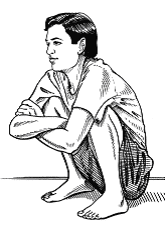
This creates a beneficial pressure in the abdominal cavity, which compresses the colon, creates a natural urge to evacuate and helps force waste out of the body.
But there is more...
2) Protection of Appendix and Small Intestine
The colon - which comprises the cecum, ascending colon, transverse colon, descending colon, sigmoid colon, rectum and anus - is connected to the small intestine through the ileocecal valve.
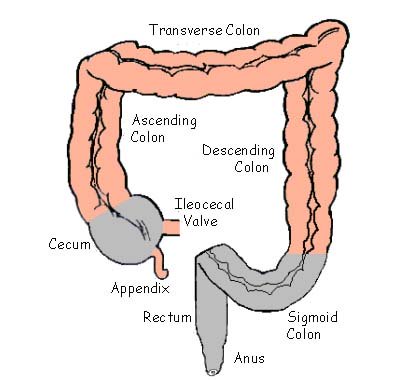
The ileocecal valve acts as a one-way valve. It allows food wastes in the small intestine to enter the colon, but prevents fecal waste in the colon from leaking into the small intestine.
In the squatting position, the right thigh – pressing on the right side of the abdomen – squeezes the pouch-like cecum and force liquid waste upwards into the ascending colon and away from the appendix.
Hence, in the squatting position, the ileocecal valve is sealed securely, and both the appendix and small intestine are kept clean.
3) Release of Bend in Sigmoid Colon
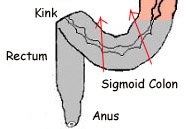 The colon also a kink or bend where the sigmoid colon joins to the rectum.
The colon also a kink or bend where the sigmoid colon joins to the rectum.
In the squatting position, the left thigh – pressing on the left side of the abdomen – supports and lifts up the sigmoid colon. This raising of the sigmoid colon opens up the kink to allow waste to flow easily into the rectum.
4) Straightening of Final Pathway
Just as there is an inlet valve (the ileocecal valve), there is also an outlet valve in the colon: the puborectalis muscle.
In the sitting position, the puborectalis muscle grips the rectum in a 'choked' position to maintain continence (prevent accidental release of stools from the anus).
In the squatting position, it relaxes its grip so that the pathway to the anus is straightened, to allow waste to pass out freely and easily.
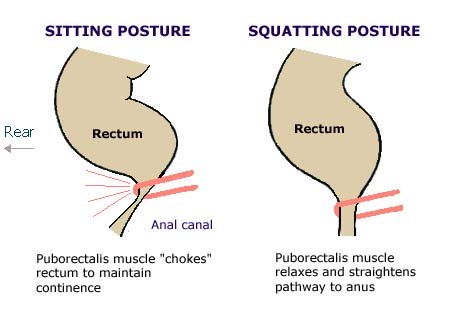
Truly, our colon is a marvel of nature!
The Case Against Sitting Toilets
By forcing users to sit instead of squat, the sitting toilet ignores ALL the natural requirements for effective waste evacuation:
1) Without pressure from the right and left thighs, no intra-abdominal pressure is created to facilitate expulsion of waste
2) Without the action of the right thigh, there is no squeezing action to direct waste upwards and away from the appendix and small intestine
3) Without the action of the left thigh, the natural bend between the sigmoid colon and rectum is not released
4) The
pathway between the rectum and anus
is not straightened
The outcome is obvious: difficult in passing stools. In frustration, one has to strain while holding the breath in order to 'push' downwards with the diaphragm (Valsalva Maneuver) in order to evacuate waste.
Yet, in spite of all the straining, the colon cannot be emptied completely.
Sadly, the impact of sitting toilets on young children is more serious.
When a tall adult uses a sitting toilet, his feet rest on the floor and his thighs are raised upwards at a slight angle and brought nearer to his abdomen and chest. He can also easily bend his chest forward to bring it closer to his thighs.
(Comment: This action to close the distance between the abdomen and thighs is not the same - or does not bring the benefits - as the full natural squatting position. But it is not as bad as the totally upright sitting position.)
But for young children who have shorter legs, the story is different. With their legs hanging over the toilet bowl and feet not touching the floor, they don't have any leverage to raise their thighs or bend their chest forward easily.
As a result, their colon is left totally unsupported.
It is worth noting that
toddlers would instinctively squat,
if sitting potties/toilets and well-meaning adults don't come into the picture.
| Have Interesting Personal Experiences or Stories About Squatting? Share Them With Visitors! |
What You Can Do... If You Want To Squat?
The best way, if you want to adopting the squatting position for your bowel movements, is to install a squat toilet. But check with your plumber if this can be done.
If installing a squatting toilet is not feasible, you could consider 'converting' your sitting toilet into a squatting type, by using a toilet squatting platform.
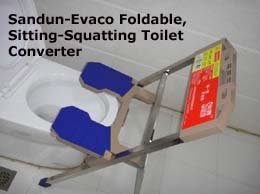
Book Recommendation

|
[Click here to find out more about Nature Knows Best...]
Ross Horne's Article on Squatting Versus Sitting
Benefits of Squatting
The Roadmap To Colon Health
Testimonials About Squatting
Share Your Personal Experience or Story About Squatting
Go to Home Page
The Best Toilet Converter in The World Today!


Helping People All Over
The World Achieve
Good Health Through
Correct Toileting Posture
Watch video on the
origin and story of
the Sandun-Evaco
toilet converter
All about Life,
Hope and Truth...
FREE:
One of the most
astounding books
you will ever read
in your life!





